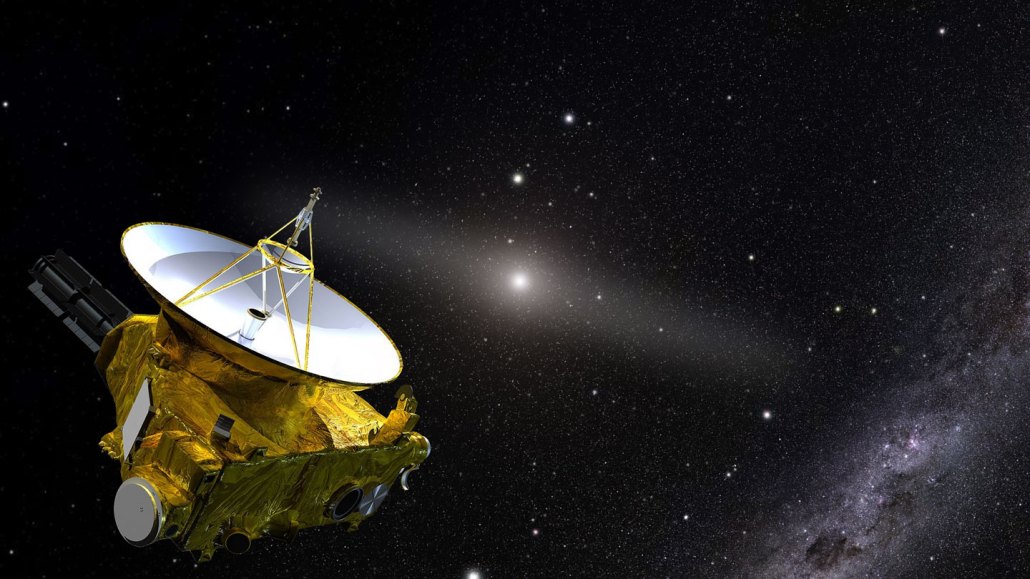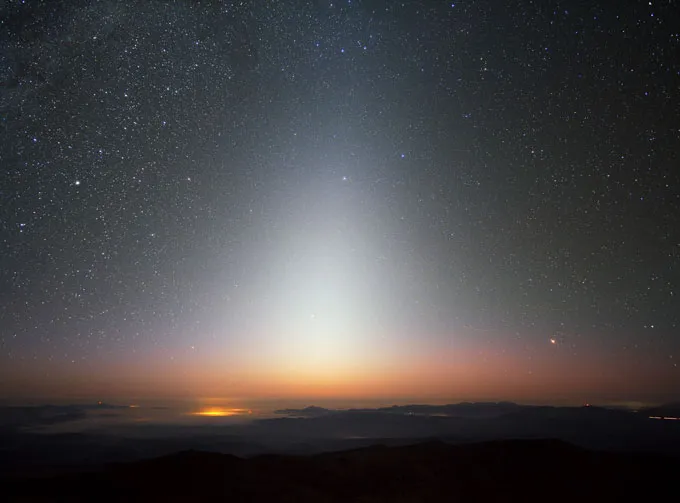
From a vantage point far from the sun and light-scattering interplanetary dust (illustrated, center), the New Horizons spacecraft is well-positioned to measure the visible background glow of the universe.
NASA, Joseph Olmsted/STScI
Even when you remove the bright stars, the glowing dust and other nearby points of light from the inky, dark sky, a background glow remains. That glow comes from the cosmic sea of distant galaxies, the first stars that burned, faraway coalescing gas — and, it seems, something else in the mix that’s evading researchers.
Astronomers estimated the amount of visible light pervading the cosmos by training the New Horizons spacecraft, which flew past Pluto in 2015, on a spot on the sky mostly devoid of nearby stars and galaxies (SN: 12/15/15). That estimate should match measurements of the total amount of light coming from galaxies across the history of the universe. But it doesn’t, researchers report in the March 1 Astrophysical Journal Letters.
“It turns out that the galaxies that we know about can account for about half of the level we see,” says Tod Lauer, an astronomer at the National Science Foundation’s NOIRLab in Tucson, Ariz.
For decades, astronomers have measured the extragalactic background light in different wavelengths, from radio waves to gamma rays (SN: 8/23/13; SN: 11/29/18). This provides a census of the universe and gives researchers hints into the processes that emit those types of light.
But the background visible light — dubbed the cosmic optical background, or COB — is challenging to measure from the inner solar system. Here, lots of interplanetary dust scatters sunlight, washing out the much fainter COB. The Pluto-visiting New Horizons spacecraft, however, is far enough from the sun that scattered sunlight doesn’t flood the spacecraft’s images.

So in September 2021, Lauer and colleagues pointed the spacecraft’s LORRI camera toward a patch of sky and took a bunch of pictures. They digitally removed all known sources of light — individual stars, nearby galaxies, even heat from the spacecraft’s nuclear power source (SN: 2/18/16) — and measured what was left to estimate the COB.
Then they used large archives of galaxy observations, like those from the Hubble Space Telescope, to calculate the light emitted by all the galaxies in the universe. The measured COB is roughly twice as bright as that calculation.
While Lauer’s group previously noted a discrepancy, this new measurement reveals a wider difference, and with smaller uncertainty. “There’s clearly an anomaly. Now we need to try to understand it and explain it,” says coauthor Marc Postman, an astronomer at the Space Telescope Science Institute in Baltimore, Md.
There are several astronomical reasons that could explain the discrepancy. Perhaps, says Postman, rogue stars stripped from galaxies linger in intergalactic space. Or maybe, he says, there is “a very faint population of very compact galaxies that are just below the detection limits of Hubble.” If it’s the latter case, astronomers should know in the next couple years because NASA’s recently launched James Webb Space Telescope will see these even-fainter galaxies (SN: 10/6/21).
Another possibility is the researchers missed something in their analysis. “I’m glad it got done; it’s absolutely a necessary measurement,” says astrophysicist Michael Zemcov of the Rochester Institute of Technology in New York who was not involved in this study. Perhaps they’re missing some additional glow from the New Horizons spacecraft and its LORRI instrument, or they didn’t factor in some additional foreground light. “I think there’s a conversation there about details.”
Sign up for our newsletter
We summarize the week's scientific breakthroughs every Thursday.
The light that reflects off the Milky Way’s dust, for example, is “a very subtle beast,” Zemcov says, “and our uncertainties likely get dominated by it at some point, just because it’s not very well understood.” Several projects in the next few years, such as the CIBER-2 experiment and the space mission SPHEREx, could help astronomers understand this pesky dust-scattered light, Zemcov says.
In addition, he and his research group member, astrophysicist Teresa Symons, are poring through hundreds of old LORRI images of dark sky and running their own analyses. Meanwhile, Lauer and his colleagues will take more pictures of other patches of sky with LORRI to strengthen their confidence in the measurement of the background light and to better understand intrusions from the spacecraft itself.
“There is something going on that we weren’t expecting,” Zemcov says, “which is where the fun part of science kicks in.”







